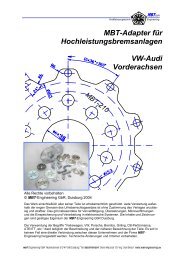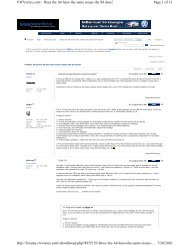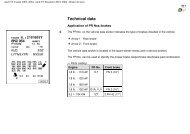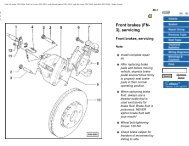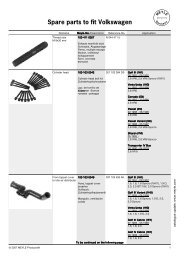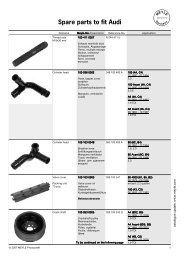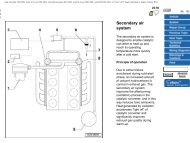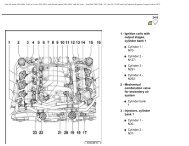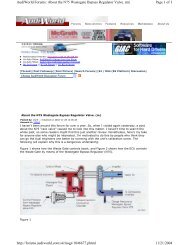VW MKII A2 MK2 Golf Jetta Fox Service Manual - VAGLinks.com
VW MKII A2 MK2 Golf Jetta Fox Service Manual - VAGLinks.com
VW MKII A2 MK2 Golf Jetta Fox Service Manual - VAGLinks.com
You also want an ePaper? Increase the reach of your titles
YUMPU automatically turns print PDFs into web optimized ePapers that Google loves.
2C•12 Engine repair procedures - 1.6 and 1.8 litre 8 valve<br />
12.12a Inserting a valve into the cylinder<br />
head<br />
4 The valve springs must be renewed if they<br />
are damaged, distorted, or known to have<br />
covered a high mileage. If in doubt as to their<br />
condition, have your <strong>VW</strong> dealer check them<br />
for <strong>com</strong>pression efficiency using a calibrated<br />
valve spring <strong>com</strong>pressor.<br />
5 The valves should be cleaned and checked<br />
for signs of wear or burring. Where this has<br />
occurred, the inlet valve may be reground on<br />
a machine at a dealer. Exhaust valves must<br />
not be reground on the machine but ground in<br />
by hand. On engines fitted with hydraulic<br />
tappets, valves should not be re-cut as this<br />
will adversely affect the operation of the<br />
tappets.<br />
6 Wear in the valve guides may be detected<br />
by fitting a new valve in the guide and<br />
checking the amount that the rim of the valve<br />
will move sideways when the top of the valve<br />
stem is flush with the top of the valve guide.<br />
The valve rock limits are given in the<br />
Specifications. New valve guides must be<br />
fitted and reamed by your <strong>VW</strong> dealer.<br />
7 Do not spend too long grinding in the<br />
valves. If the valve seat and valve are not<br />
satisfactory after 15 minutes then you will<br />
probably do more harm than good by going<br />
on. Make sure both surfaces are clean, smear<br />
grinding paste onto the valve evenly and using<br />
a suction cup, work the valve with an<br />
oscillating motion lifting the valve away from<br />
the seat occasionally to stop ridging. Clean<br />
the seat and valve frequently and carry on<br />
until there is an even grey band on both seat<br />
and valve then wipe off all the paste.<br />
8 The surface of the head must be checked<br />
with a straight-edge and feeler blade. Place<br />
the straight-edge along the centre of the<br />
machined face of the head. Make sure there<br />
are no ridges at the extreme ends and<br />
measure the clearance with feelers between<br />
each <strong>com</strong>bustion chamber head. This is the<br />
area where the narrowest part of the cylinder<br />
head gasket <strong>com</strong>es and where the gasket is<br />
most likely to fail. If the straight-edge is firmly<br />
in place and feelers in excess of 0.1 mm can<br />
be put between the head and the<br />
straight-edge, then the head should be taken<br />
to a dealer for servicing or replacement.<br />
9 If the cylinder head shows signs of<br />
cracking, have it inspected by your <strong>VW</strong> dealer<br />
to assess its condition for reuse.<br />
10 <strong>VW</strong> re<strong>com</strong>mend that the valve stem oil<br />
seals should always be renewed to prevent<br />
possible high oil consumption. Pulling off the<br />
old seal is simple with pliers. With a packet of<br />
new oil seals is a small plastic sleeve. This is<br />
fitted over the valve stem and lubricated. The<br />
seal should then be pushed over the plastic<br />
sleeve until it seats on the guide. This should<br />
be done with <strong>VW</strong> tool 10 204 which fits snugly<br />
round the outside of the seal and pushes it on<br />
squarely. If the seal is assembled without the<br />
plastic sleeve, it will be damaged and oil<br />
consumption will be<strong>com</strong>e excessive.<br />
11 Before reassembling the cylinder head,<br />
check the condition of the camshaft.<br />
12 When all <strong>com</strong>ponents have been<br />
examined, then assembly of the head may<br />
<strong>com</strong>mence. Insert the valve in the correct<br />
guide, fit the inner seat, valve springs and<br />
outer cap, assemble the valve spring<br />
<strong>com</strong>pressor and possibly the small tube and<br />
<strong>com</strong>press the valve spring until the collets<br />
12.14 Fit the tappet buckets 12.15 Fit the bearing caps<br />
12.12b Locating valve springs and cap . . . 12.12c . . . and valve collets<br />
1081 <strong>VW</strong> <strong>Golf</strong> & <strong>Jetta</strong><br />
may be assembled to the valve stem (see<br />
illustrations).<br />
13 Assemble the second collet and holding<br />
them carefully together in place, ease off the<br />
<strong>com</strong>pressor until the spring seats the collets<br />
home. Remove the <strong>com</strong>pressor, put a rag<br />
over the valve stem and tap the stem with a<br />
hammer. This is to ensure that the collets are<br />
seated correctly. If they are they will not <strong>com</strong>e<br />
out. Repeat until all eight valves are in position<br />
in the cylinder head.<br />
14 Refit the tappets in the bores from which<br />
they came, lubricating them liberally with<br />
clean engine oil (see illustration). Lubricate<br />
the camshaft bearing surfaces with oil and fit<br />
the camshaft, positioned so that No 1 cylinder<br />
cams point upwards.<br />
15 Fit a new oil seal at the sprocket end,<br />
lubricate the bearings, set the shaft in position<br />
and install bearing caps Nos 2 and 4,<br />
tightening the nuts in a diagonal pattern until<br />
the shaft is in place (see illustration). Now<br />
install the other bearing caps, making sure<br />
they are the right way round (marks towards<br />
the drive pulley) and tighten the caps down<br />
using a diagonal pattern to the specified<br />
torque. Install a new rubber seal at the<br />
opposite end to the sprocket.<br />
16 On engines equipped with shim bucket<br />
tappets, adjust the valve clearances.<br />
13 Sump and oil pump - removal<br />
and refitting 3<br />
Modification: From August 1985, a larger<br />
sump is fitted thereby increasing engine oil<br />
capacity. If renewing the sump, ensure that<br />
one of identical capacity is fitted<br />
Removal<br />
1 If the engine is in the vehicle then drain the<br />
engine oil. Note that the sump plug has an<br />
O-ring which must be renewed (see<br />
illustration).<br />
2 Undo the sump retaining bolts and remove<br />
the sump from the lower face of the<br />
crankcase. Remove the sump gasket which<br />
must also be renewed.<br />
3 To remove the oil pump, undo the two<br />
retaining bolts and lower the pump unit,



